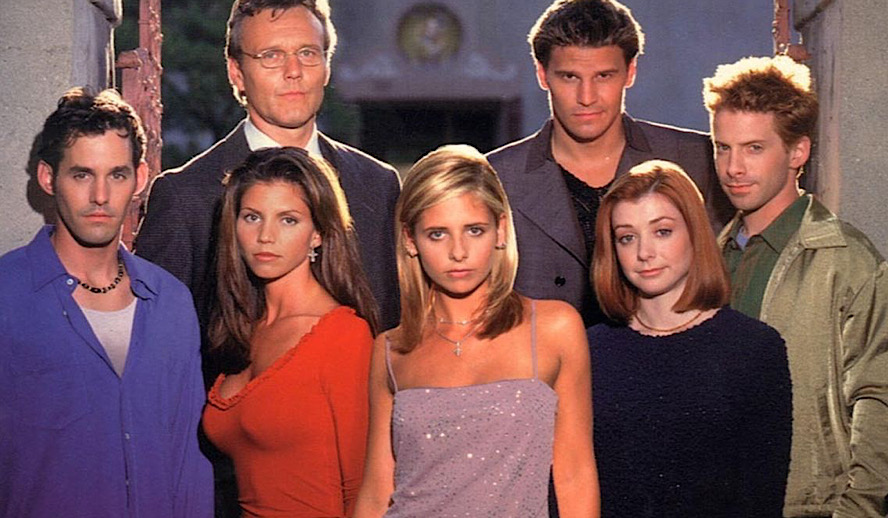Table of Contents

Photo: ‘Buffy the Vampire Slayer’/Hulu
January 19, 2021, marked the 40th birthday of the beloved, kickass, pun-slinging vampire slayer Buffy Summers, expertly played with strength, vulnerability, and humor by Sarah Michelle Gellar. While the TV series ‘Buffy the Vampire Slayer’ is gaining on its 25th anniversary, many people expressed on social media how meaningful it was to reflect on Buffy’s milestone birthday. Gellar remarked on Instagram about Buffy on the character’s 40th birthday: “She taught that the hardest thing in the world is to live in it. So in her honor let’s all be brave. Live. This may not be the way we are used to living our lives, but let’s find the beauty. So we can all live long and safely.”
Related article: Was The Blockbuster Movie ‘300’ Political Satire in Disguise?
Related article: Pride Month: Hollywood Insider Pays Tribute To LGBTQ Films 1918-Now
Buffy the Vampire Slayer Popularity
Based on the 1992 movie of the same name written by series creator Joss Whedon, ‘Buffy the Vampire Slayer’ ran for seven seasons from 1997 to 2003 on The WB and later UPN, eventually expanding the ‘Buffyverse’ to the spin-off series ‘Angel’ and numerous novels and comic books. I was born the year ‘Buffy’ came out in 1997, and so it wasn’t on my radar until many years later. But once I started watching the series, I was immediately enamored with it. Buffy’s unabashed strength and snark when taking on vampires and demons were empowering. Her heart-wrenchingly human moments of going through her first breakup or losing her mother were entirely devastating. Watching this dynamic, layered, reluctant superhero grow up has helped me articulate my own feelings about entering adulthood and the way that everyone can be brave by living even when it’s hard. And that’s just the tip of the iceberg (or headstone?).
It sometimes feels that there are too many reasons to count why the show means so much to me even though it’s so removed from my own coming of age. For those who watched ‘Buffy’ while it was airing in the late ’90s and early ’00s or came to it later but had lived through that time, there tends to be a great sense of nostalgia, especially for folks who were growing up alongside the characters. While I’m a generation removed from the original viewers of the show, it still resonates with me deeply (and with friends who I’ve converted into fans). It is my belief that you either love ‘Buffy the Vampire Slayer’ or you haven’t watched it yet. For faithful fans and for the uninitiated, here are five reasons ‘Buffy’ still matters today and will for years to come.
Subscribe to Hollywood Insider’s YouTube Channel, by clicking here.
1. Subverting Gender and Genre Stereotypes
Buffy Summers is a teenage girl in the fictional town of Sunnydale, California who just wants to be normal. She’s blonde, pretty, small in stature, and happens to be the latest in a long line of slayers, girls who are chosen to fight against vampires and the forces of darkness and imbued with supernatural strength and reflexes. It’s not a mantle Buffy accepts at first—she doesn’t want to be the Chosen One, she wants to go to school and the mall, hang out with her friends, date! But the reluctant hero rises to her calling, protecting the town from vampires and other baddies. And she saved the world. A lot.
‘Buffy’ skillfully weaves together supernatural horror, comedy and action, and teenage drama and romance. On the DVD commentary for “Welcome to the Hellmouth,” the first episode of ‘Buffy’, Whedon described, “The first thing I ever thought of when I thought of Buffy, the movie, was the little […] blonde girl who goes into a dark alley and gets killed in every horror movie. The idea of Buffy was to subvert that idea, that image, and create someone who was a hero where she had always been a victim.”
“I’m the thing that monsters have nightmares about,” Buffy says in one of her classic speeches. And even though it’s incredible to see this young woman handily dispatch demons five times her size without compromising her personality or femininity, one of the best things about Buffy is that she’s flawed. She can be selfish even though she’d die—twice—to save the world. She’s got a bit of a god complex and has trouble communicating in her romantic relationships. But she tries and fails, she learns and grows. Buffy may be a superhuman in a supernatural world, but the depth of her character makes her incredibly real. We can empathize with her and relate to her.
Related article: The Power of Positivity: Ikorodu Bois + Chris Hemsworth + Russo Brothers + Sam Hargrave
Limited Time Offer – FREE Subscription to Hollywood Insider
In a 2001 interview, Whedon said, “I designed ‘Buffy’ to be an icon, to be an emotional experience, to be loved in a way that other shows can’t be loved. Because it’s about adolescence, which is the most important thing people go through in their development, becoming an adult. And it mythologizes it in such a way, such a romantic way—it basically says, ‘Everybody who made it through adolescence is a hero.’ And I think that’s very personal, that people get something from that that’s very real.”
2. Groundbreaking Style and Form
“What’s the sitch?” “A world of no.” “She’s got the wiggins.” “Make with the slayage.” “We’re five by five.” If you understand those phrases, you’re likely well-versed in “Buffyspeak,” or “Buffyisms.” Cher Horowitz gave us some prime ’90s slang in the iconic movie ‘Clueless’, but ‘Buffy’ reigns supreme in terms of popularizing obscure phrases and for its enduring impact on linguistics. There’s even a book about it called Slayer Slang: A Buffy the Vampire Slayer Lexicon, not to mention numerous other academic articles. The unique voice of the show, which makes it so quotable, is still regarded as a huge influence on popular culture, creating a teen-specific language on TV that sounded more like how real teenagers talked.
Buffyspeak isn’t the only thing that had a bearing on later TV shows. Let’s face it, if you’ve watched a TV show made in the last 20 years, odds are it’s had season arcs and a major antagonist or threat each season. You can thank ‘Buffy’ for that. At a time when most TV shows were entirely episodic, each episode depicting a self-contained story, long-term character and villain arcs were novel. While most ‘Buffy’ episodes feature monster-of-the-week plots, episodes throughout each season devote time to building up the season’s overarching threat. ‘Buffy’ even coined the term “Big Bad” to refer to the main antagonist of the season.
Related article: Hollywood Insider’s CEO Pritan Ambroase: “The Importance of Venice Film Festival as the Protector of Cinema”
Related article: The Masters of Cinema Archives: Hollywood Insider Pays Tribute to ‘La Vie En Rose’, Exclusive Interview with Director Olivier Dahan
In addition to subverting genre tropes, ‘Buffy’ wasn’t afraid to break convention in stylistically-unique episodes. “Hush,” a nearly-silent episode in a show praised for its clever dialogue, still manages to be funny, whimsical, and arguably the scariest ‘Buffy’ episode ever. “The Body” depicts the devastating loss of a parent through long takes, an absence of music, and the mundane anxieties that arise out of grief, like deciding what to wear. “Once More, with Feeling” is the celebrated musical episode that fits seamlessly into the overarching storylines of the season and simply happens to contain terrific songs and dance routines.
A study found that ‘Buffy the Vampire Slayer’ is the most written about pop culture property by academics, a field which is referred to as ‘Buffy’ studies. There are numerous scholarly articles about the show’s innovation and bearing on popular cultures, such as the previously mentioned linguistics book, as well as essays examining topics like feminist themes, religious allusions, and connections to classical philosophy. There’s even an academic journal dedicated to ‘Buffy’ called Slayage that started in 2001 and is still publishing.
3. High School is Hell
Most people think high school is hell. But what if it really was? Sunnydale High School is situated on a Hellmouth, a hotspot of demonic and supernatural activity that makes the town popular with all kinds of creepy baddies. It also has a way of bringing out the horrors of high school in very literal ways. A girl who feels unseen by her peers turns invisible. Misogynistic swim team boys turn into fish monsters. When Buffy loses her virginity to her ensouled, good vampire boyfriend Angel (David Boreanaz), he loses his soul and turns evil, a nightmare come true for a teenager who fears her boyfriend will cast her aside as soon as they’ve had sex. One of the great storytelling feats of ‘Buffy’ is depicting adolescent struggles that feel so big and “apocalypse-y” as actually being the apocalypse. Buffy would love to be in her room studying, but she has to save the world—again!
Related article: Robert Pattinson Biography: 32 Facts on the Reluctant Star of ‘Tenet’, ‘Batman’ & ‘Twilight’ Series
At first glance, Buffy doesn’t seem like an outsider at her high school, but the burden of being the Chosen One weighs on her and she doesn’t feel like she fits in with the popular crowd, which she used to before becoming the Slayer. Instead, she becomes friends with shy and nerdy Willow (Alyson Hannigan) and goofy, self-deprecating Xander (Nicholas Brendon). The trio is often bullied or looked down upon by the popular kids, vain Cordelia (Charisma Carpenter) in particular, but they embrace their weirdness and help each other tackle demons and homework, making them easy to root for. Through combining the supernatural elements of the show with normal life, ‘Buffy’ depicts everyday teenage challenges to be as monumental as they feel, which resonates with audiences whether you’re in high school or not.
4. Lovable Characters
The characters make the show, and that’s no different in ‘Buffy’. But what stands out is how nuanced and layered each of the characters are. Buffy, as the central character, is of course one of the best-written, but every character from the core four—Buffy, Willow, Xander, and Watcher Giles (Anthony Head)—to villains to recurring characters are dynamic and complex. What separates Buffy from previous slayers is her insistence that she maintain a normal life, going to high school, living with her mom, and spending time with her friends. It’s the friendships and Buffy’s relationship with stuffy and endearing Giles, her mentor and surrogate dad, that emotionally ground the show. In addition to the weekly slayage, it’s captivating to watch Willow’s evolution as she becomes a more self-assured person and powerful witch and Xander’s journey in taking on more responsibility in his work as he navigates adulthood. Even Cordelia becomes more compassionate the more time she spends with the so-called Scooby Gang.
The villains of the series are some of the most fun characters. British vampires Spike (James Marsters) and Drusilla (Juliet Landau) and the quirky, family values–focused Mayor (Harry Groener) are particular favorites. And rogue Slayer Faith (Eliza Dushku) made a lasting mark as Buffy’s wilder, more aggressive foil. No redemption arc is as compelling as Faith’s, though most of it occurs on the spin-off ‘Angel’. Even so, Faith’s presence elevates the final episodes of ‘Buffy’ when she fights alongside the Scoobies. What the series does so well is showcase the many sides of every character, depicting both the heroes and villains as complex individuals whose morality is often gray or shifting.
Related article: FACT-CHECKED Series: Leonardo DiCaprio and 32 Facts on the Legendary Star
Romantic relationships also play a huge part in the series, from Buffy’s first love relationship with good vampire Angel to the darker one she later develops with bad boy Spike. Willow’s journey through her first relationship with werewolf guitarist Oz (Seth Green), then later coming into her sexuality as a gay woman and falling in love with fellow witch Tara (Amber Benson), is heartfelt and compelling. Willow and Tara’s relationship was one of the first depictions of a long-term, loving lesbian relationship on TV, and the first lesbian sex scene on network TV occurs in the final season of ‘Buffy’, continuing the cultural importance of the show. Ex-demon Anya (Emma Caulfield), who is turned human again, struggles with navigating human life and customs, humorously taking a blunt or tactless approach to situations. Her relationship with Xander helps her better understand humanity. Whether with love, friendship, or fraught frenemy-ship, seeing the characters supporting one another through thick and thin is one of the many reasons fans keep returning to ‘Buffy’.
5. Honest Depiction of Growing Up
It might seem strange that within a TV show filled with vampires, demons, and magic, there are wonderfully and terribly real moments. Yet genre fiction has always excelled at using these fantastical elements to reveal the human truths at the center, such as Sunnydale High School being located on the Hellmouth. At the beginning of the show, Buffy is a sophomore in high school who never quite fit in because of all the supernatural weirdness that took precedence in her life. We follow her journey of accepting her role as the Chosen One, see her through her first love and first heartbreak, and her transition to college. We see Buffy grieving the loss of her mother and struggle with newfound adult responsibilities like raising her younger sister and paying the bills. We watch as Buffy battles depression after being brought back from the dead and see her become the leader of an army of potential slayers fighting the First Evil. In following Buffy’s change and growth throughout the seasons, we see her battle demons and adolescent troubles, fight against evil, and against becoming an adult. But Buffy kept fighting, kept living, and continually gives us the strength to do the same.
Related article: FACT-CHECKED Series: Armie Hammer and 32 Facts About Our Mega-Star
Related article: FACT-CHECKED Series: Timothée Chalamet and 32 Things About This Extraordinary Superstar
In one of the most emotional scenes of the series (and that’s saying something), Buffy finally gets her perfect high school moment. After saving the school dance from hellhounds in the season three episode “The Prom,” Buffy gets dressed up and makes it in time for the awards ceremony. She’s alone at the back of the gym when Jonathan (Danny Strong), the announcer, asks if Buffy is there tonight. A spotlight drifts over to her as he reads a speech from the prom committee. “We don’t talk about it much, but it’s no secret that Sunnydale High isn’t really like other high schools. A lot of weird stuff happens here,” Jonathan reads. “But whenever there was a problem or something creepy happened, you seemed to show up and stop it. Most of the people here have been saved by you or helped by you at one time or another.”
Jonathan finishes by saying that the senior class is giving Buffy the first-ever Class Protector Award. The gym erupts with applause and cheers, and there’s a swell of orchestral music as Buffy makes her way to the stage to accept the award. The scene never fails to make me cry. Buffy may have missed out on a lot of parts of high school while she was out saving the world, but her efforts didn’t go unnoticed by her peers, and she was celebrated for the very thing that often burdened her with feeling different.
Conclusion
For all its triumphs, ‘Buffy’ does have its flaws. Take a look at any scene in the series, and most of the actors you’ll see are white. The few characters of color in the show generally only appear in one episode or are eventually killed off. Many of its depictions of race haven’t aged well. And even in such a groundbreaking and feminist show, it’s not without misogyny. Oftentimes the show depicts misogynistic characters or situations that Buffy and the Scoobies will clearly denounce as wrong and defeat them. But other times, such as Xander’s sexualizing remarks about his friends, the misogyny goes unchecked. It’s not a perfect show, but as with any media, it’s important to watch it with a critical eye and acknowledge its faults.
Related article: A Tribute to Brad Pitt: His Greatest Roles & Transformations – The Winner’s Journey
Related article: A Tribute to Tom Hardy: Tracking the Master Actor’s Epic Career & Transformations
Yet even by today’s standards, the show’s storytelling still ranks high with its dynamic and complex female characters, the seasons-long character development and emphasis on found family, and how it juggles memorable Big Bads and individual monsters-of-the-week. ‘Buffy’ still resonates with fans for how it consistently manages to be scary and funny, emotional and absurd. And my favorite by far: how the show honestly portrays being a teenager and transitioning into adulthood. The show is so watchable and rewatchable because its themes, messages, and characters and their journeys are still relatable to audiences of all ages. Even after nearly 24 years, the popularity of ‘Buffy’ endures as strongly as ever. There are still conventions, podcasts like Buffering the Vampire Slayer, academic journals and books, fan art and fan fiction, and fan sites dedicated to discussing aspects of the show from who is the best love interest for Buffy to breaking down the academic theory in ‘Buffy’ studies articles. The list goes on.
‘Buffy’ has many lessons to teach us, like the importance of allowing yourself to open up to and rely on your friends or being brave by living. But perhaps one of the best messages the show has to offer is in the season two finale episode “Becoming, Part 2.” Angel has lost his soul and turned into the evil Angelus. Buffy is trying to stop Angelus from sucking the world into hell, and during a fight, Buffy is disarmed and knocked to the ground. “No weapons… no friends… no hope,” Angelus taunts as he advances on her. “Take all that away and what’s left?” Angelus jabs his sword at Buffy’s face, but she deftly catches the blade between her palms. Buffy looks at him defiantly and says, “Me.”
Stream ‘Buffy the Vampire Slayer’ and ‘Angel’ on Hulu now.
Click here to read Hollywood Insider’s CEO Pritan Ambroase’s love letter to Black Lives Matter, in which he tackles more than just police reform, press freedom and more – click here.
An excerpt from the love letter: Hollywood Insider’s CEO/editor-in-chief Pritan Ambroase affirms, “Hollywood Insider fully supports the much-needed Black Lives Matter movement. We are actively, physically and digitally a part of this global movement. We will continue reporting on this major issue of police brutality and legal murders of Black people to hold the system accountable. We will continue reporting on this major issue with kindness and respect to all Black people, as each and every one of them are seen and heard. Just a reminder, that the Black Lives Matter movement is about more than just police brutality and extends into banking, housing, education, medical, infrastructure, etc. We have the space and time for all your stories. We believe in peaceful/non-violent protests and I would like to request the rest of media to focus on 95% of the protests that are peaceful and working effectively with positive changes happening daily. Media has a responsibility to better the world and Hollywood Insider will continue to do so.”
More Interesting Stories From Hollywood Insider
– Want GUARANTEED SUCCESS? Remove these ten words from your vocabulary| Transform your life INSTANTLY
– Compilation: All James Bond 007 Opening Sequences From 1962 Sean Connery to Daniel Craig
– Do you know the hidden messages in ‘Call Me By Your Name’? Find out behind the scenes facts in the full commentary and In-depth analysis of the cinematic masterpiece
– A Tribute To The Academy Awards: All Best Actor/Actress Speeches From The Beginning Of Oscars 1929-2019 | From Rami Malek, Leonardo DiCaprio To Denzel Washington, Halle Berry & Beyond | From Olivia Colman, Meryl Streep To Bette Davis & Beyond
– In the 32nd Year Of His Career, Keanu Reeves’ Face Continues To Reign After Launching Movies Earning Over $4.3 Billion In Total – “John Wick”, “Toy Story 4”, “Matrix”, And Many More
buffy, buffy, buffy

Claire L. Wong is a writer from the San Francisco Bay Area who strives to advance intelligent analysis, diversity, and compassionate storytelling in her work. She especially likes writing about science fiction, action, AAPI, and LGBTQ+ stories. She believes that visual storytelling through film and television increases the practice of empathy, which aligns with Hollywood Insider’s goal to use meaningful entertainment as a unifying tool. (she/her)








